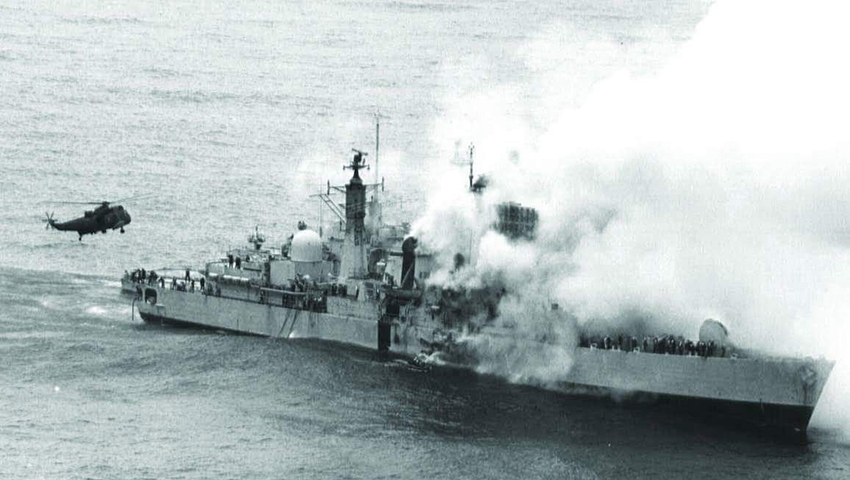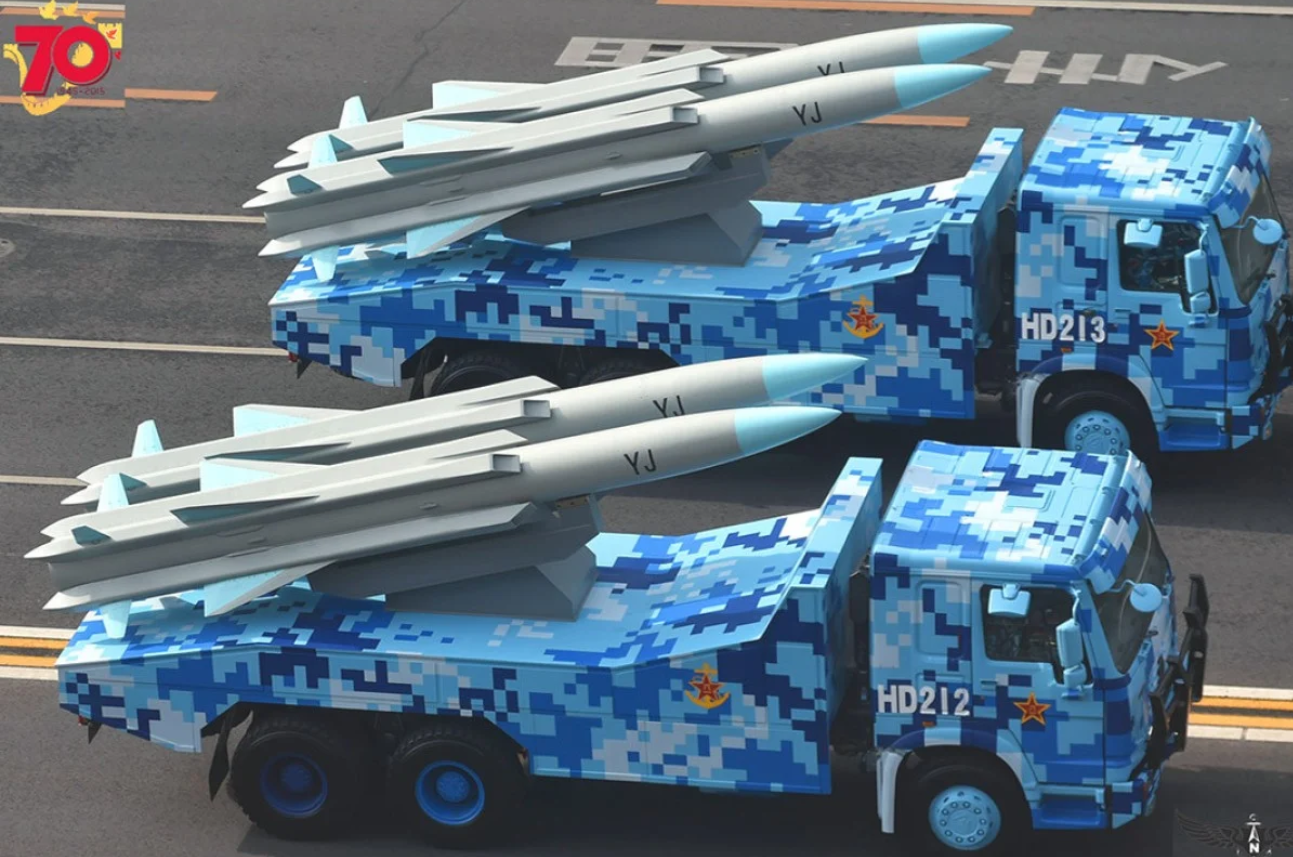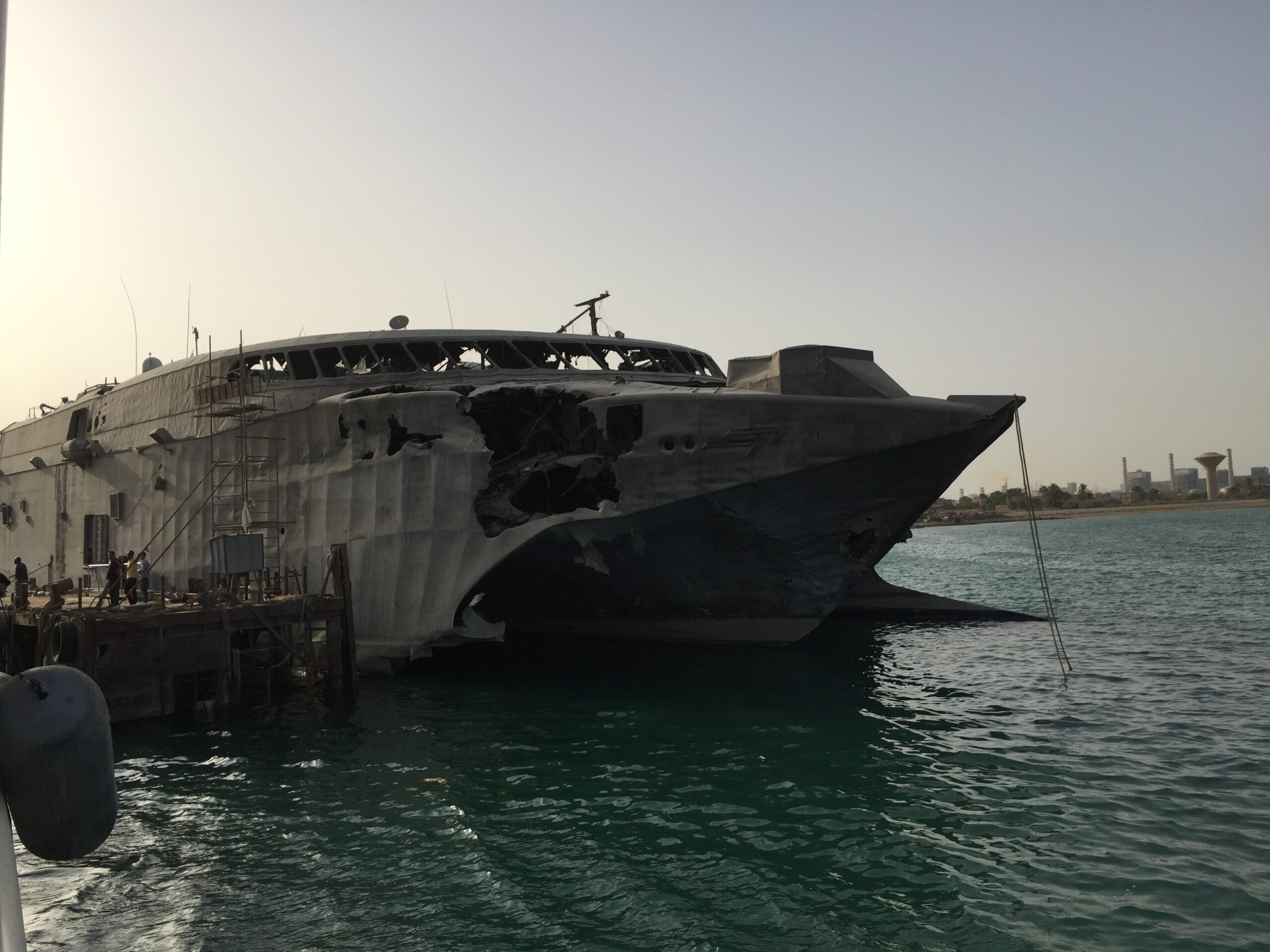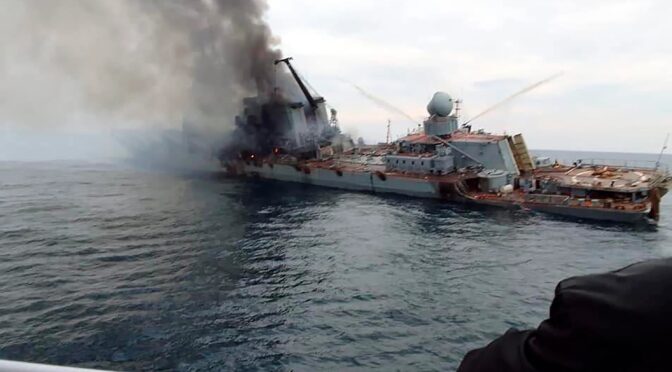By Steve Wills
The recent loss of the Russian Navy guided missile cruiser RFS Moskva from a cruise missile strike called forth many comparisons to previous losses of large surface combatants, including the Argentine cruiser ARA General Belgrano and even the Japanese super dreadnought Yamato. Only a few however remembered the HMS Sheffield from the Falklands War. While Moskva was a large and capable surface warship that invited comparisons with the losses of larger combatants, the Russian cruiser’s demise may have much more in common with that of the Royal Navy Type 42 destroyer than Belgrano or any World War II warship.
The birth of the modern cruise missile in the Cold War, and the many sensors, communication tools, and other systems needed to use or defend against anti-ship missiles set the stage for a whole new era in naval warfare. A series of unfortunate events laid the British warship open to attack and a similar version of those events may have doomed Moskva as well. Modern warships are very much “eggshells armed with hammers” and even one hit is enough to put the ship out of combat action or cause her sinking. As the 40th anniversary of the first successful cruise missile attack of the Falklands War recently transpired, it is useful to review the fate of HMS Sheffield to understand what her loss and the loss of the Moskva mean for war at sea now and in the future.
Sentinels in Dangerous Littorals
Air defense is one of the most challenging warship missions in the current environment of cruise and ballistic missiles, as well as conventional aircraft threats. Sheffield and Moskva were both on the front lines of their respective wars serving as air defense units protecting other ships from air and missile attack. Sheffield acted as a picket vessel with the mission of engaging any aircraft and missiles that threatened the British task group aircraft carriers HMS Hermes and HMS Invincible. Moskva’s task organization is unknown, but as the Black Sea Fleet’s best air defense warship she likely would have been providing air and missile defense for other nearby Russian warships.
A warship’s defense posture matters greatly in her ability to effectively respond to air and missile attack. That readiness may also depend on other ships in the same task group. Sheffield was nominally prepared to respond to air and missile attack, but several factors limited her responsiveness. According to the post-attack investigation and subsequent revelations, Sheffield’s anti-air warfare officer was out of the operations room at the time of the attack, and a satellite telephone call caused interference with the ship’s electronic support measures (ESM) gear. That disruption blinded the ship’s ability to “see” the inbound missile and by the time lookouts identified the attacking weapon it was too late for Sheffield to respond with weapons and countermeasures. Sheffield’s crew might have been excused for that issue, except a battle was raging around them at the same time with other British task force units tracking supposed missile contacts. The other British air defense destroyer HMS Glasgow was in the process of trying to identify an air threat to the group, but the time from the start of Glasgow’s engagement of the unknown aircraft to impact of the Exocet missile fired by one of those aircraft was less than 3.5 minutes. Missile warfare is fast-paced and any degradation in readiness can be fatal.

Moskva may also have been engaged in normal activity that masked the ability of her onboard sensors as did Sheffield’s satellite phone call. Moskva may have disregarded the threat of air and missile attack to the point that, like a later cruise missile victim USS Stark (also hit by Exocet missiles in 1987,) her defenses were turned off and not available. Warships must always be vigilant in littoral waters where the risk of cruise missile attack is greater due to closer range to shore-based platforms and limited time for response. The Israeli corvette Hanit escaped severe damage or loss from such a surprise attack in 2006 only because the missile did not arm and struck a glancing blow.
What history shows us is that many warships that have fallen victim to anti-ship missile attacks were struck because of poor readiness and situational awareness. These ships were not struck because their defenses could not hold their own against overwhelming missile salvos. Rather, these ships were struck by exceedingly small salvos of only one or two missiles, attacks they were expected to be able to manage handedly. But poor readiness and awareness resulted in their defenses being virtually absent from the engagement, allowing small missile strikes to wreak enormous damage.

Eggshells armed with Hammers
Winston Churchill was perhaps one of the first recorded personalities to describe modern warships as eggshells with hammers, but his description is even more valid today than when he was first quoted as saying it in 1914. Heavy armor for the sides (armor belts,) decks, gun turrets, conning towers, and other critical command and control or engineering sections was common in warship construction from the period of the American Civil War through the end of World War II. While evaluations of armor effectiveness were mixed, it was assumed that some amount of steel plate was useful in protecting large and medium warships from damage. Destroyer-sized ships and smaller lacked much armor, but still had some additional protection around gun mounts. Today by contrast only the largest ships such as aircraft carriers have armor. HMS Sheffield was a destroyer but was larger than her World War II counterparts and might have carried armor. Moskva was a cruiser and previous cruisers had moderate armor protection, but the Russian cruiser too was unarmored. What changed to the point where most warships eschewed armor protection altogether, especially in the face of cruise missile attack?
The addition of missiles and the electronic tools needed to search for opponents and guide weapons to targets fundamentally changed warship design in the early Cold War. Missiles were not turret mounted, and at first were fired from rotating launchers and later from vertical tubes inside the hull. Sensors needed to be placed on tall masts, and to keep the ship stable, the missiles and other heavy gear needed to be mounted lower in the ship. This suggests armoring a ship’s hull, but weapons technology changed in many ways with the introduction of the missile. These weapons were large in the case of those designed as ship killers with even early versions possessing 1,000-pound warheads. Some anti-ship missiles can strike a ship at supersonic speeds and deliver an amount of kinetic force that rivals battleship shells. Later variants possessed shaped-charge warheads that upon impact inject a superheated molten jet into the armor, melting a hole for the rest of the warhead to follow. (The Javelin missile employed so effectively by Ukrainian troops against Russian tanks has a shaped-charge warhead.) In addition, the introduction of nuclear weapons served to make armor pointless. While target ships survived terrible atomic test blasts, the radiation from those weapons could not be deflected and would have killed crews without the weapons that carried them penetrating the ship.

Once a missile penetrates and explodes, the damage it inflicts can rapidly immobilize or render a warship unusable. The Exocet missile that hit Sheffield did not explode, but it ruptured a fuel oil tank and fragments from the impact ruptured the ship’s firefighting water system. Deprived of water to fight fires, the crew of the Sheffield were driven from the ship to its exposed decks forward of the bridge and aft of the helicopter hanger; a situation that hampered firefighting efforts. Moskva’s final pictures also show heavy damage, from missile impacts in the middle of the ship (amidships) and many scorch marks emanating from port holes and other undamaged sections suggesting a massive fire. Commercially available wargames have also suggested that the Slava-class cruiser (Moskva was named Slava before her 2000 refit) could survive multiple cruise missile hits, but in this case seems to have succumbed to just two hits from medium-sized weapons.
This is not surprising and not a new development. The robust warships from the World War II era, including capital ships, could be immobilized with one or two torpedo hits as well. Even one cruise missile hit can be disastrous to a small or medium-sized ship as evidenced by the 2016 cruise missile attack on the former U.S. High Speed Vessel Swift, then operated by the United Arab Emirates (UAE.) Even an unarmed drone can make a large hole in a ship as evidenced by the 2013 accidental collision of a 270lb target drone and the cruiser USS Chancellorsville during a tracking exercise. Moskva may still have been filled with flammable paneling in her officer’s quarters and had poorly maintained damage control gear as one of the author’s NATO colleagues reported after a 2007 visit to the ship. But most warships today other than large aircraft carriers qualify as eggshells armed with hammers.

Sheffield and Moskva: A Common Fate?
The Sheffield, like Moskva, was not immediately sunk by her cruise missile hit, but instead lingered for several days until she sank in rough seas whilst being towed toward South Georgia island for emergency repairs. Moskva too appears to have initially survived but sank later, and it does not take too much change in weather to sink a heavily damaged warship.
The continuing lesson to be learned from cruise missile warfare is what legendary naval tactics professor Wayne Hughes taught his students for nearly four decades. Hughes always said, “attack effectively first.” Do not be on the receiving end of a cruise missile attack as history suggests there me be only minutes or even seconds to respond. The opposition must be denied the information that allows them to target and fire upon warships with confidence, while priority must be given to securing similar targeting information for one’s own forces to fire first.
Sheffield could not see the missile that fatally damaged her until it was too late to respond and Moskva may have suffered a similar fate. Advanced cruise missiles are now part of many nations’ weapon arsenals and continue to improve in terms of speed, maneuverability, range, and effectiveness. The lessons from both the Moskva and Sheffield cruise missile attacks are not new revelations for naval warfare, but rather the timeless reminder that those who do not prepare their ships and crews to face the most prevalent threats may suffer a tragic fate.
Dr. Steven Wills is a navalist for the Center for Maritime Strategy at the Navy League of the United States. He is an expert in U.S. Navy strategy and policy and U.S. Navy surface warfare programs and platforms. His research interests include the history of U.S. Navy strategy development over the Cold War and immediate, post-Cold War era, and the history of the post-World War II U.S. Navy surface fleet.
Featured Image: The Russian cruiser Moskva following an April 13, 2022 strike from Ukrainian missiles. (OSINT Technical via Twitter)


Agree with all of this. But there are also broader and deeper issues. The best defense in the littoral is to not go there. Thus you need very long range offense, and that is much cheaper to acquire with missiles than aircraft. If you have to venture into a threatened littoral, it is best to do so with vessels that are easier to hide and/or more numerous such that when losses do occur the overall force degrades dradually rather than catastrophically. An offensive missile posture involves less training and maintenance costs than does aviation. I am not saying the Navy does not need carrier aviation, just that duking it out against numerous missile forces in the littoral constitutes misuse of the ship type. There are strategic risk issues connected to command of the sea that are ameliorated via making the fleet’s offense missile- centric. Wayne Hughes taught us about the math of missile salvoes and the implications thereof. The Navy has yet to embrace that lesson.
Thanks Barney!
What about the examples of ships defending themselves from cruise missile attacks in the littorals?
I can think of at least two, 1991 Persian gulf where a near sister of Sheffield defended a US Battleship and a couple of years ago where a US Burke class DDG intercepted / decoyed several cruise missiles shot at her.
The real issue as the author discussed is the readiness and preparedness of the ship and crew.
With a 513Kg warhead, that SY-2 MIGHT have caused some significant damage to the Missouri, but it is worth noting the Pearl Harbor experience. For example, two hits by bombs converted from 14″ AP shells failed to penetrate the top armor of Tennessee, which was barely over half of what an Iowa carried. Maryland had two penetrate, but outside the armor belt and the hull was patched for her to sail to Puget Sound within a week. Pennsylvania had a Mk X torpedo from USS Downes launched as a missile at her by an explosion, and the damage in front of the armor belt was patched within 5 days and fully repaired within two months. Six bombs hit Nevada, with the significant damage coming from hits outside the armor belt and a torpedo below it. California settled from flooding from two torpedo hits, but DID take one significant hit from a bomb converted from an AP shell that penetrated the deck armor, half as thick as an Iowa. West Virginia took a significant bomb hit to the unarmored superstructure, but was sank by multiple torpedo hits. Oklahoma’s fatal damage was from torpedoes. Arizona, of course, DID take a catastrophic penetration of the 5″ armored deck, although four other hits did only minor damage. Those do offer some reason to believe that a ship with 6″ armored decks would have stood a reasonable chance of surviving or shaking off a pop-up ASM.
You are right but how will the armor affect in other areas such as engine configuration, speed, and fuel consumption.
Warships prior and during WWII tended to be top heavy in service, the result of their hulls, weapons, and other components being made of various iterations of iron. Radar and other sensors quickly demonstrated their value by the end of the war, replacing the top heavy dilemma with a volume critical issue. Nuclear weapons made armor and its large margin in warships moot, and as well, damage control features were pared away, the result being the loss of HMS Sheffield from a single dud because it was a weak, voluminous structure that had no redundancy in its damage control systems (notorious cost cutting, including an insane predilection with reducing length and displacement with no benefit and great net cost in overall ship utility, also heavily degraded the Type 42 destroyers). Bad warship design is the result of meddling by career types who should learn to get over the love of the sound of their own voice, not cost or lack of viable design solutions.
I have no military training – simple math suggests that with no missile reloads realistically available at sea one can overwhelm the targets w/simply too many missiles. THis assumes both adversaries hve the same defensive and offensive # of missiles and equal ECM/ESM skills. This is not very scientific. What am I missing?
For all the disparagement that occurs regarding warship armor, it certainly would offer an opportunity to reduce damage and contain it. Today’s destroyers are the size of Second World War cruisers (a Burke is similar in size to a Brooklyn-class light cruiser) and certainly could carry more armor than just some light Kevlar liners to block splinters. A belt and deck armor of even 1-2 inches of STS around the VLS, the 5″ magazine, the engine spaces, the bridge, and the CIC could go a long way towards reducing damage, particularly with armored watertight bulkheads both longitudinal and lateral to contain damage from a hit. It wouldn’t assure survivability, but it would improve it. Given the limited number of platforms modern Western navies are maintaining in operation, anything to keep them fighting would be useful
But how long did it take to make any of those ships combat ready again? On today’s ships one hit would likely constitue a mission kill, so it would have to retire and perhaps be escorted. We must then consider what fraction of the task force offensive and defensive power was contained in that ship. If too much, then the task force commander or JFMCC would face a nasty choice: incur even grater risk by proceeding on mission or retreat like the Japanese at Savo. Your calculations concerning armor vs missiles is likely correct, but I don’t see the application in modern fleet design.
I am skeptical that ships can effectively defend against cruise missiles (or ballistic missiles) on any consistent basis. The limited experience that we have in such encounters seems to always end with the ship going down. The entire purpose of the Moskva was to defend against such threats and it failed spectacularly against a below-state-of-the-art pair of missiles. Where is there an example of a successful defense?
There are a couple examples of successful defenses, including in the Gulf War and the 2016 Red Sea attacks. The Israelis in 1973 defeated every anti-ship missile fired against them through electronic warfare. But these were all very small salvos like the examples the authors used. We have yet to see truly large volumes of anti-ship missile salvos be fired against high-end warships in the way that has been envisioned for more than half a century at this point. Our understanding of who really has the advantage in the offensive/defensive balance of naval salvo combat remains imprecise.
Why didn’t the author list the sinking of the INS Eilat in Oct 1967, as I remember it changed US Navy training right after it happened.
I note from the authors comments that it was thought that a mere phone call using Sheffield’s satellite system caused a problem with onboard sensors. This is a slight understatement as the real issue was the use of the satellite system for sending messages back to London which was fairly standard. Nothing to do with phone calls but using the system for main communications as it was very efficient and reliable. It was known by many in the field that this particular setup on Sheffield and the use of its satellite system often blocked the use of a certain onboard sensor.